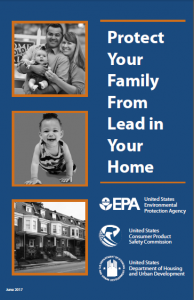Tom Neltner, J.D., is Chemicals Policy Director
Lead poisoning prevention advocates should mark May 14, 2021 as a consequential day in our collective efforts to protect public health. Last week, two decisions and a preliminary report were issued that lay a solid foundation for further progress. When translated into action, the decisions and report should result in significantly reduced lead exposure for children. These developments were:
- A court ruling on lead-based paint hazard standards: The U.S. Court of Appeals for the Ninth Circuit directed the Environmental Protection Agency (EPA) to reconsider – and most likely tighten – the agency’s 2019 revisions to its lead-based paint (LBP) hazard standard that define the levels of lead in paint, dust, and soil that are dangerous. The current standards remain in place until EPA revises them to comply with the law and the court’s order. This decision has significant implications for home renovations, real estate disclosures, lead cleanups, and homeowner testing. This welcome step toward stronger protections for children was only possible thanks to Earthjustice and the petitioners that challenged EPA’s flawed rule.
- Lowered federal elevated blood lead level: The Centers for Disease Control and Prevention’s (CDC) Lead Exposure and Prevention Advisory Committee (LEPAC) unanimously recommended that the agency lower its blood lead reference level (aka “elevated blood lead level” or EBLL) from 5 micrograms per deciliter (µg/dL) of lead in young children’s blood to 3.5 µg/dL. CDC appears ready to act on the recommendation. When it does, the decision will have significant implications for state and local health and housing agencies reacting to blood lead testing results for at-risk children and for action levels for lead in food.
- New national survey of lead-based paint hazards: The U.S. Department of Housing and Urban Development (HUD) presented to LEPAC the preliminary results of its American Healthy Homes Survey II (AHHS-II), a long-overdue update to its 2006 survey. This survey of lead-based paint hazards serves as the basis for federal agencies to set priorities, assess impacts of policy decisions, and track progress. The results of samples taken in 2018-19 shows modest but significant progress across many demographics including African American households, government-supported households, and households in poverty – most likely an indication that the federal investment to fix low-income housing is paying off.
These actions put added urgency to President Biden’s America Jobs Plan that includes $45 billion in federal funding to fully replace the nation’s 9 million lead service lines and $213 billion for housing – both critical aspects of our nation’s infrastructure that need a lead poisoning prevention-oriented upgrade. We encourage Congress to provide at least $19 billion as part of an investment in housing to reduce lead-based paint hazards in pre-1940 housing, especially by replacing old, single-pane windows to get the combined benefits of safer and more energy efficient homes.












